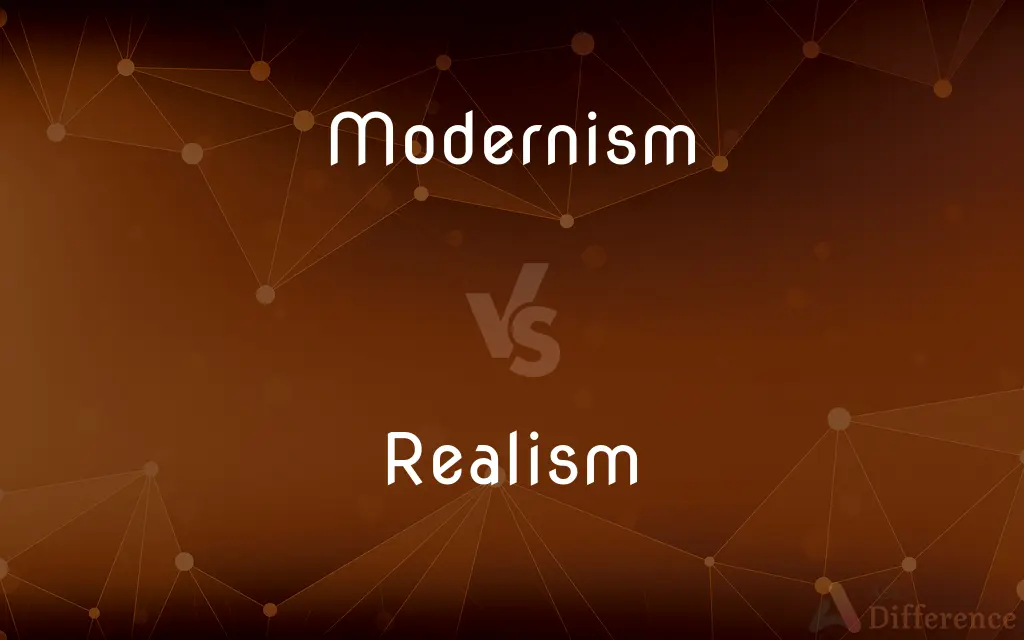Modernism vs. Realism — What's the Difference?
By Maham Liaqat & Urooj Arif — Updated on March 20, 2024
Modernism emphasizes experimental forms and subjective experiences, focusing on breaking from tradition; Realism portrays life accurately, prioritizing objective depiction over imagination.

Difference Between Modernism and Realism
Table of Contents
ADVERTISEMENT
Key Differences
Modernism, emerging in the late 19th and early 20th centuries, sought to break away from established norms and traditions, experimenting with form, structure, and narrative techniques. It aimed to capture the essence of modern life and its complexities. Realism, on the other hand, emerged in the mid-19th century as a response against romanticism, focusing on depicting everyday life and society with an emphasis on accuracy and detail.
Modernist literature often features a fragmented structure, stream of consciousness, and a strong focus on the inner experiences and psychology of characters. This approach reflects the modernist perception of a fragmented world. Whereas, Realism is characterized by its detailed descriptions, linear narratives, and well-developed characters, aiming to present life as it is, without embellishment or idealization.
Modernism is marked by its embrace of the abstract and the innovative, seeking new ways to express the human condition. It often incorporates symbolism, metaphor, and non-linear storytelling. Realism, however, adheres to the principle of representing reality as closely as possible, using straightforward and clear language.
In modernism, the theme of alienation, existential angst, and disillusionment is prevalent, reflecting the tumultuous times of the early 20th century, including wars and technological advancements. Realism focuses on societal norms, class, gender, and the challenges of the ordinary individual, offering a critical mirror to society.
Modernism encourages readers to interpret and engage with the text, often leaving meanings ambiguous and open-ended. It challenges readers to see beyond the surface. Realism provides a more accessible and straightforward narrative, making it easier for readers to understand and relate to the story and characters.
ADVERTISEMENT
Comparison Chart
Time Period
Late 19th - early 20th century
Mid-19th century
Focus
Subjective experiences, innovation
Accurate depiction of life, objectivity
Narrative Style
Fragmented, stream of consciousness
Linear, detailed
Themes
Alienation, disillusionment, existential angst
Societal norms, class, gender, daily challenges
Language and Form
Experimental, abstract, symbolic
Straightforward, clear, detailed
Compare with Definitions
Modernism
A cultural movement embracing innovation and rejecting traditional forms.
James Joyce's Ulysses exemplifies modernism with its stream of consciousness technique.
Realism
Cinema that focuses on natural acting and plausible scenarios.
The Italian Neorealism movement produced films like Bicycle Thieves, highlighting everyday struggles.
Modernism
Art that prioritizes the abstract and conceptual over realistic representation.
Picasso's cubist paintings reflect modernist tendencies.
Realism
Art that captures subjects as they appear in everyday life.
Jean-François Millet's paintings depict rural life with realism.
Modernism
Music that incorporates atonality and new structures.
Arnold Schoenberg's compositions introduced modernist elements to classical music.
Realism
A movement aiming to depict life accurately without artistic manipulation.
Gustave Flaubert's Madame Bovary is a cornerstone of literary realism.
Modernism
Literature characterized by experimental forms and themes of alienation.
T.S. Eliot's The Waste Land captures modernist themes of disillusionment.
Realism
Literature focusing on everyday life and social settings.
Mark Twain's The Adventures of Huckleberry Finn showcases realism in American literature.
Modernism
Architecture that emphasizes function and new materials.
The Bauhaus school advocated modernist principles in design.
Realism
Theatre that portrays realistic characters and situations.
Henrik Ibsen's plays are known for their realistic portrayal of 19th-century society.
Modernism
Modernism is both a philosophical movement and an art movement that arose from broad transformations in Western society during the late 19th and early 20th centuries. The movement reflected a desire for the creation of new forms of art, philosophy, and social organization which reflected the newly emerging industrial world, including features such as urbanization, new technologies, and war.
Realism
An inclination toward literal truth and pragmatism.
Modernism
Modern thought, character, or practice.
Realism
The representation in art or literature of objects, actions, or social conditions as they actually are, without idealization or presentation in abstract form.
Modernism
Sympathy with or conformity to modern ideas, practices, or standards.
Realism
The scholastic doctrine, opposed to nominalism, that universals exist independently of their being thought.
Modernism
A peculiarity of usage or style, as of a word or phrase, that is characteristic of modern times.
Realism
The modern philosophical doctrine, opposed to idealism, that objects exist independently of their being perceived.
Modernism
Often Modernism The deliberate departure from tradition and the use of innovative forms of expression that distinguish many styles in the arts and literature of the 1900s.
Realism
A concern for fact or reality and rejection of the impractical and visionary.
Modernism
Often Modernism A Roman Catholic movement, officially condemned in 1907, that attempted to examine traditional belief according to contemporary philosophy, criticism, and historiography.
Realism
An artistic representation of reality as it is.
Modernism
(uncountable) Modern or contemporary ideas, thought, practices, etc.
Realism
(sciences) The viewpoint that an external reality exists independent of observation.
Modernism
(countable) Anything that is characteristic of modernity.
Realism
(philosophy) A doctrine that universals are real—they exist and are distinct from the particulars that instantiate them.
Modernism
Any of several styles of art, architecture, literature, philosophy, etc., that flourished in the 20th century.
Realism
As opposed to nominalism, the doctrine that genera and species are real things or entities, existing independently of our conceptions. According to realism the Universal exists ante rem (Plato), or in re (Aristotle).
Modernism
A religious movement in the early 20th century, condemned as heretical by Pope Pius X, which tried to reconcile Roman Catholic dogma with modern science and philosophy.
Realism
Fidelity to nature or to real life; representation without idealization, and making no appeal to the imagination; adherence to the actual fact.
Modernism
Modern practice; a thing of recent date; esp., a modern usage or mode of expression.
Realism
The practise of assessing facts and the probabilities of the consequences of actions in an objective manner; avoidance of unrealistic or impractical beliefs or efforts. Contrasted to idealism, self-deception, overoptimism, overimaginativeness, or visionariness.
Modernism
Certain methods and tendencies which, in Biblical questions, apologetics, and the theory of dogma, in the endeavor to reconcile the doctrines of the Roman Catholic Church with the conclusions of modern science, replace the authority of the church by purely subjective criteria; - so called officially by Pope Pius X.
Realism
The attribute of accepting the facts of life and favoring practicality and literal truth
Modernism
Genre of art and literature that makes a self-conscious break with previous genres
Realism
(philosophy) the philosophical doctrine that physical object continue to exist when not perceived
Modernism
The quality of being current or of the present;
A shopping mall would instill a spirit of modernity into this village
Realism
The state of being actual or real;
The reality of his situation slowly dawned on him
Modernism
Practices typical of contemporary life or thought
Realism
An artistic movement in 19th century France; artists and writers strove for detailed realistic and factual description
Realism
(philosophy) the philosophical doctrine that abstract concepts exist independent of their names
Common Curiosities
What defines modernism in literature?
Modernism in literature is defined by its experimental approach to narrative structure, theme, and character, focusing on the inner experiences of individuals and reflecting the complexities of modern life.
Why is realism considered important in art?
Realism is considered important in art for its role in making the ordinary and overlooked aspects of human life visible and worthy of artistic representation.
Can a work be both modernist and realist?
While modernism and realism have distinct characteristics, some works may blend elements of both, reflecting the complexities of human experience and artistic expression.
What is the significance of realism in literature?
Realism is significant in literature for its focus on depicting the lives, struggles, and social conditions of ordinary people, often highlighting issues of social justice and the impact of societal norms.
How did modernism affect architecture?
Modernism significantly impacted architecture by introducing new materials, functional design principles, and the rejection of ornamentation in favor of simplicity and efficiency.
What themes are common in modernist works?
Themes in modernist works include alienation, existential angst, disillusionment, and the breakdown of social and cultural norms.
Did modernism influence music?
Yes, modernism greatly influenced music by introducing atonality, experimental forms, and new approaches to musical composition and performance.
How does realism differ from other art movements?
Realism differs from other art movements by its commitment to depicting life as it truly is, without idealization or artistic distortion, focusing on ordinary people and everyday situations.
Why did modernism emerge?
Modernism emerged as a reaction against traditional norms and the perceived inadequacy of previous art and literature to express the realities of the modern world, including technological advancements and the disillusionment following World War I.
How does the narrative style differ between modernism and realism?
Modernism often employs fragmented narratives and stream of consciousness, while realism uses linear narratives and detailed descriptions to depict life accurately.
Are modernist works difficult to understand?
Modernist works can be challenging due to their experimental forms and often ambiguous themes, requiring active engagement and interpretation by the reader.
What is the legacy of modernism and realism?
The legacy of modernism and realism lies in their profound impact on subsequent generations of artists and writers, influencing how we perceive and represent the human condition and the world around us.
Is realism only a literary movement?
No, realism is not only a literary movement; it encompasses art, theatre, cinema, and other forms of cultural expression that aim to accurately depict reality.
What role does society play in realist literature?
In realist literature, society often plays a central role, with authors critically examining social norms, class distinctions, and the impact of societal changes on individuals.
How do modernism and realism view technology?
Modernism often incorporates themes of technology as a symbol of modern life's complexities and challenges, while realism may depict technology's impact on society and daily life more straightforwardly.
Share Your Discovery

Previous Comparison
Barley vs. Hop
Next Comparison
Encase vs. EncloseAuthor Spotlight
Written by
Maham LiaqatCo-written by
Urooj ArifUrooj is a skilled content writer at Ask Difference, known for her exceptional ability to simplify complex topics into engaging and informative content. With a passion for research and a flair for clear, concise writing, she consistently delivers articles that resonate with our diverse audience.
















































